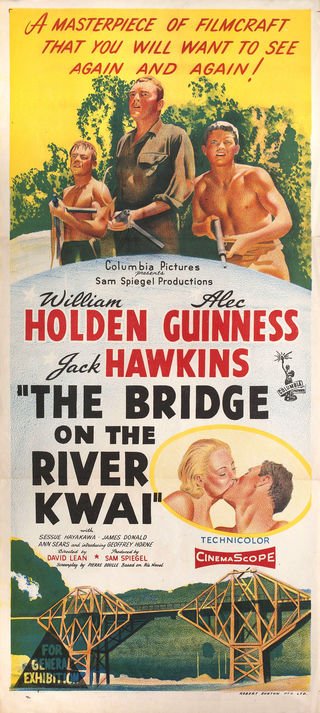The Bridge on the River Kwai (1957)
So, during a session of binge-watching parks and recreation, I decided that Ron Swanson’s favorite movie, The Bridge on the River Kwai was an easy choice for the next Movie of the Week. The film takes place in a Japanese prison camp in 1943 where British prisoners of war are forced to build a bridge. (guess where…)
I thought I was pleasantly surprised at how much I enjoyed The Shawshank Redemption, this was a whole new level. Staring a young Obi Wan Kenobi, Sir Alec Guinness was fantastic as the honor before everything Colonel Nicholson. He instantly became one of my favorite characters of all time.
Winning the Best Picture, Best Actor, and Best Director that year for both the Golden Globes and the Oscars does not surprise me one bit. The remaining four Oscars it won for Best Screenplay Based on Material from Another Medium, Best Cinematography, Best Film Editing, and Best Music were also very well deserved. Sessue Hayakawa earned Best Supporting actor nominations from both organizations as well for his portrayal of Colonel Saito but unfortunately did not win.
When ABC decided to air the film on t.v. all in one night, instead of in two parts, setting a record at the time for the longest single network telecast of a movie. This made me laugh because I watched the movie in 2 parts. With the way the film flows it worked very well in my opinion. Plus, with a 161-minute run time, it’s nice to have a break in the middle.
If I were to choose one word to describe this film, it would be Honor. All three of the main characters however all see honor a little differently.
For the British Colonel Nicholson, it’s about respect for and from his fellow men. It’s about doing the right thing according to the British and International laws, even if it means death.
For the Japanese Colonel Saito, it’s a deep respect for the military and the Japanese culture. Failure to complete the bridge means he must sacrifice his life.
For the American Commander Shears, there is no honor is needless death. Compared to Col. Nicholson he comes across as a bit of a coward, but this is also why his story and journey is so intriguing.
There were a lot of specific scenes I loved. I really enjoyed the opening shot of all the bamboo cross grave markers along the railroad. The introduction of a hopeless Commander Shears and it is both depressing and humorous. My favorite part of the whole movie is when the British prisoners march into camp whistling the “Colonel Bogey March” and we get to meet Col. Nicholson. Strangely high spirited for prisoners in their condition showing their loyalty to their commanding officer. That scene combined with the first day of work on the bridge where the officers stood still the entire day refusing to work following the Geneva Conventions shows how badass this troop is. (although Japan had not signed the Geneva Conventions until 1953)
Saito pulls Nicholson out of the “oven” and invites him to dinner (not an actual oven, that would make a very awkward dinner) and pleads with Nicholson that if the bridge is not completed on time, he will be forced to kill himself, but Nicholson will not budge and force his officers to work. Saito takes over command of the bridge construction personally and still the building goes slowly. This brings us to my other favorite scene. Saito uses the anniversary of a 1905 Japanese victory in a battle with Russia (I think the Battle of Mukden) to declare amnesty with Nicholson and the British troops. By using this anniversary, he is able to save face by appearing kind and generous while hiding his defeat by Nicholson. Nicholson then stands up straight, buttons up his shirt, and goes to shake the hands of all the officers as they are released from their punishment confinement to thank them for their sacrifice.
Shears was my least favorite of the main three characters. He featured much more prominently in the second half where after his escape we find out that he has been impersonating an officer the whole time and was only a swab jockey. The British use this to get shears to help them lead a team of 4 to destroy the bridge being built.
The ending had me speechless for a little while. I’m still not too sure what to say. It was not how I was expecting it to finish, at least not exactly, and it wrapped up everything going on very well. Quite frankly, it was too good for me to go into much detail. It is a long movie, but it is well worth your time. If you don’t have much time and want to watch it in two sittings like I did, I would suggest stopping right after the British officers meet with the Japanese at about 74 minutes in.


